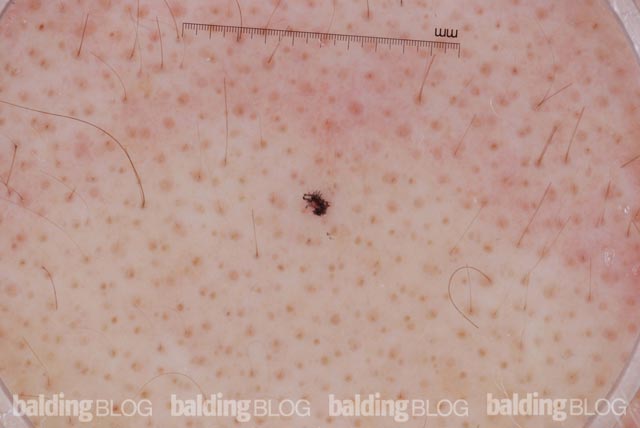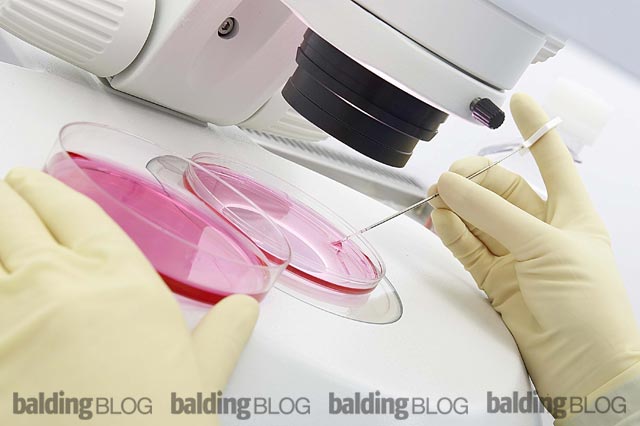Release from Intercytex: PDF file
They still believe that this can be a marketable product, the question as an expert what do you make of this data? It does say that more data will be released later this year i’m presuming photos.
Our newest author on BaldingBlog, Dr. Bessam Farjo, is intimately familiar with Intercytex. The following response comes from him:
—
We finished following up the last volunteer of Phase II of the trial about 6 weeks ago, and the 1st set of analysis data have just been released. This trial was designed to examine the effect of different dermal papilla (the hair producing cells in the root) delivery techniques and methods to ensure that the epidermal (superficial skin layer) cells were in the correct state to respond to the signals and produce new hairs.
To recap, the point of the trial is to see if it is possible to create a limitless supply of donor hair and deliver results with very minimum of surgery. In each subject, an initial surgical harvest of around 100 hairs roots was performed, dermal papilla cells separated and then put in a proprietary culture medium for 8 weeks. In this medium the cells multiply extensively producing millions of ‘cloned’ DP cells.
 Each volunteer was injected 900 times with the suspension containing the lab-grown DP cells in a large area which was photographed at the end of the study. Volunteers were also injected in a smaller area, divided into two halves – counts were obtained by shaving and photographing the two small halves of this small area of the scalp, injecting them multiple times (either 1 injection of 50 µl or 50 injections of 1 µl) with living DP cell suspension and then applying a specialized image analysis system to provide a total hair count. In these small sections, all 19 subjects in the trial were treated using a range of injection and scalp pre-stimulation techniques; the first 6 subjects were injected without stimulation of the scalp. In the remaining 13 subjects the resident hair producing (epithelial) cells were stimulated at the time of delivery of the DP cells in one of the two treatment sites. 13 subjects completed the 48-week trial with 6 subjects lost to follow-up. Of the 13 subjects completing the trial the data showed that:
Each volunteer was injected 900 times with the suspension containing the lab-grown DP cells in a large area which was photographed at the end of the study. Volunteers were also injected in a smaller area, divided into two halves – counts were obtained by shaving and photographing the two small halves of this small area of the scalp, injecting them multiple times (either 1 injection of 50 µl or 50 injections of 1 µl) with living DP cell suspension and then applying a specialized image analysis system to provide a total hair count. In these small sections, all 19 subjects in the trial were treated using a range of injection and scalp pre-stimulation techniques; the first 6 subjects were injected without stimulation of the scalp. In the remaining 13 subjects the resident hair producing (epithelial) cells were stimulated at the time of delivery of the DP cells in one of the two treatment sites. 13 subjects completed the 48-week trial with 6 subjects lost to follow-up. Of the 13 subjects completing the trial the data showed that:
- 65% (11/17) of the treated sites in the non-stimulated group responded to the treatment by increasing numbers of hairs of all sizes
- 71% (12/17) of the treated sites in the non-stimulated group responded to the treatment by increasing numbers of hairs over 30 microns in diameter
- 78% (7/9) of the treated sites in the stimulated group responded to the treatment by increasing numbers of hairs of all sizes
- 100% (9/9) of the treated sites in the stimulated group responded to the treatment by increasing numbers of hairs over 30 micron in diameter
- The overall take rate (number of hairs produced per 100 injections) in the stimulated areas was
- 40% (n=6) for hairs of all sizes
- 18% (n=6) for hairs over 30 microns in diameter
The larger (900 injection) area photographs have not yet been analysed. As a reference, hairs under 30 microns in diameter that grow less than 1 cm in length are vellus baby-like hairs, while terminal adult-like hairs are more than 30 microns in diameter and grow more than 1cm in length.
The data strongly suggests that new hair production is improved by pre-stimulation of the scalp. This is essentially a technique to cause a minor injury to the skin surface, leading to an interaction between the injected cells and the resident hair producing cells. The role of an injury or skin wound in hair growth in mice had first been established a year or two ago by Cotsarelis and his team.
From a clinical point of view, what we have learned is that when such a technique becomes an available commercial treatment, it can be a rapid and pain free procedure. Obviously local anesthetic will be used, but certainly 1000 injections can be performed in under an hour with post op pain almost non existent and scabbing very minimal.
Further studies are of course planned, but one exciting area that may point to the way of the future is the development of the so-called Proto-Hairs. Still in the lab stage for now, animal multiplied dermal papilla cells are developing terminal hairs in the lab dish. Once this is duplicated reliably in the human model and proved to work in a human trial, it may provide another alternative to the concept of cell therapy for hair loss.
—
Learn more about the author of this article, Dr. Bessam Farjo, on his BaldingBlog profile or at his website.
Tags: intercytex, hair cloning, hair multiplication, hairloss, hair loss, farjo

 I am optimistic of a hair loss breakthrough in 10 to 15 years, but if you asked someone a decade ago, they likely would’ve said the same thing back then. A lot of people are getting tired of hearing the same old “cure in the next 10 years” talk, but I will continue to be optimistic even if that timeframe comes and goes. Baldness isn’t a life threatening illness, but it is a billion dollar business… so as long as people continue to lose hair and there’s a market to end that loss, there will be companies clamoring to come up with the next great treatment. As technology evolves, the concepts that some people came up with that were once considered ludicrous can finally start to become within reality’s reach. Don’t get me wrong — there are still plenty of ridiculous ideas that will never work to treat hair loss. We’ll just have to wait and see and try not to buy into the hype too much, because there’s been far too many letdowns over the years (like that flying car we’ve all been promised).
I am optimistic of a hair loss breakthrough in 10 to 15 years, but if you asked someone a decade ago, they likely would’ve said the same thing back then. A lot of people are getting tired of hearing the same old “cure in the next 10 years” talk, but I will continue to be optimistic even if that timeframe comes and goes. Baldness isn’t a life threatening illness, but it is a billion dollar business… so as long as people continue to lose hair and there’s a market to end that loss, there will be companies clamoring to come up with the next great treatment. As technology evolves, the concepts that some people came up with that were once considered ludicrous can finally start to become within reality’s reach. Don’t get me wrong — there are still plenty of ridiculous ideas that will never work to treat hair loss. We’ll just have to wait and see and try not to buy into the hype too much, because there’s been far too many letdowns over the years (like that flying car we’ve all been promised).



 Each volunteer was injected 900 times with the suspension containing the lab-grown DP cells in a large area which was photographed at the end of the study. Volunteers were also injected in a smaller area, divided into two halves – counts were obtained by shaving and photographing the two small halves of this small area of the scalp, injecting them multiple times (either 1 injection of 50 µl or 50 injections of 1 µl) with living DP cell suspension and then applying a specialized image analysis system to provide a total hair count. In these small sections, all 19 subjects in the trial were treated using a range of injection and scalp pre-stimulation techniques; the first 6 subjects were injected without stimulation of the scalp. In the remaining 13 subjects the resident hair producing (epithelial) cells were stimulated at the time of delivery of the DP cells in one of the two treatment sites. 13 subjects completed the 48-week trial with 6 subjects lost to follow-up. Of the 13 subjects completing the trial the data showed that:
Each volunteer was injected 900 times with the suspension containing the lab-grown DP cells in a large area which was photographed at the end of the study. Volunteers were also injected in a smaller area, divided into two halves – counts were obtained by shaving and photographing the two small halves of this small area of the scalp, injecting them multiple times (either 1 injection of 50 µl or 50 injections of 1 µl) with living DP cell suspension and then applying a specialized image analysis system to provide a total hair count. In these small sections, all 19 subjects in the trial were treated using a range of injection and scalp pre-stimulation techniques; the first 6 subjects were injected without stimulation of the scalp. In the remaining 13 subjects the resident hair producing (epithelial) cells were stimulated at the time of delivery of the DP cells in one of the two treatment sites. 13 subjects completed the 48-week trial with 6 subjects lost to follow-up. Of the 13 subjects completing the trial the data showed that: Read the full text —
Read the full text —